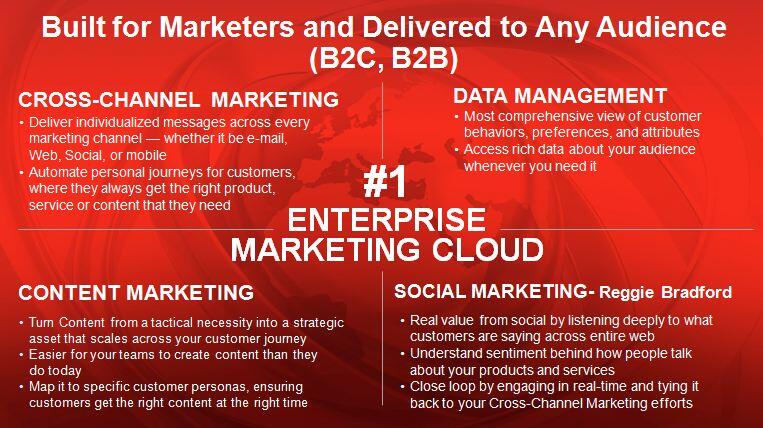Yesterday Oracle formally announced the launch of the Oracle Marketing Cloud.
If you’ve been watching the industry, you may be wondering “didn’t they already have a marketing cloud?” They’ve had all of the pieces, yes. Before yesterday there was an Oracle Social Cloud comprised of the solutions formerly known as Vitrue, Collective Intellect, and Involver. And the company had other marketing solutions including Eloqua, Responsys, Compendium, and BlueKai. As of yesterday, those pieces are now formally brought together as a single solution:

Oracle’s POV on its marketing cloud positioning (Source: Oracle)
This launch matters in the context of Oracle’s overall go-to-market and here’s what matters:
1) Potential for revenue growth.
Oracle is a $40 billion company. According to President Mark Hurd, the marketing cloud gives Oracle an application to sell in to a new audience: the marketing department. The market for enterprise applications is dominated by a handful of heavyweight contenders including SAP, Oracle, and IBM. All three of these firms are interested in leveraging their longstanding CIO/CTO relationships to connect with the CMO and become the enterprise system of record. The Marketing Cloud business is worth “hundreds of millions of dollars” modeled as annual recurring revenue and selling in to complement financials, operations, and other systems would be a strong source of revenue growth for the company. But Oracle can’t walk into a CMO’s offer with a menagerie of acquired point solutions — the single Marketing Cloud product allows sales to offer an enterprise-level platform.
2) Integration will make or break the Cloud.
Marketing Cloud General Manager Kevin Akeroyd stated the critical success factor in the near-term competitive landscape: “anyone with access to capital can acquire companies, but whoever integrates best will win.” This requires integration of code in order to facilitate data sharing between solutions; in Oracle’s case, it offers a Universal Customer Profile as the customer-centric backbone of its systems. Moreover, change management is just as important in ensuring post-merger integration success and the Oracle teams cite a high retention rate of management from Vitrue and other firms indicating positive results.
3) There’s something missing.
Oracle openly acknowledges there’s additional work to be completed in building out the Marketing Cloud solution. Although AppCloud offers connections to a wide variety of point solutions, Oracle still needs a tightly integrated solution to deliver on the need for marketing metrics tied to business objectives. And not just social media measurement or web analytics — marketers need customer-focused omnichannel metrics with proper attribution to understand campaign performance.
Final thought: social becoming increasingly siloed
It’s interesting to see Oracle’s Social Cloud subsumed by the larger Marketing Cloud. While social media had its heyday and undoubtedly plays an important role in customer engagement strategy, it’s ultimately just one element in the larger marketing picture. Over the course of this year, look for the word “social” to disappear from product offerings and marketer lexicons, just as “.com” disappeared from company names and logos once brands discovered that digital business is really just “business.”
In the other direction, the cloud competition is becoming increasingly expansive and the stakes can’t get much higher. James Bond fans might remember the video game that Sean Connery plays in Never Say Never Again called “Domination,” that delivers electric shocks to the loser. Except in this case the price of defeat is going to cost a lot more than $267,000.


